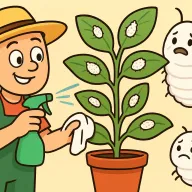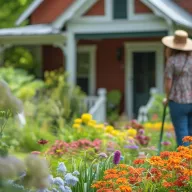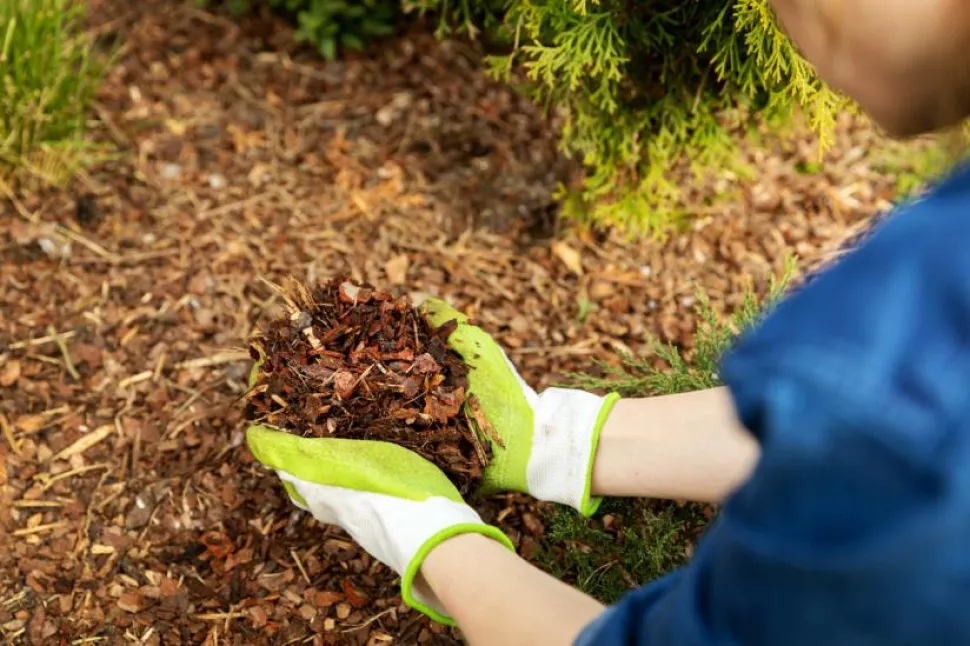
All you need to know about mulching
Article for :Beginner and plant killerExperienced plant lover
Do you dream of a productive vegetable garden, lush hedges and flowerbeds without spending too much time on them? Would you like a garden that uses less water and fertilizer? Mulching makes it possible. This technique allows you to spare your efforts and the resources used to care for your crops. Here's how.
What are the advantages of mulching?
Mulching involves covering the soil around plantings with an organic, mineral or textile material.
It can be used in both the garden and the vegetable patch. You can mulch the base of vegetables, flowers, trees and shrubs, whether in pots or in the ground.
The benefits are numerous. This simple gesture improves growing conditions and limits the gardener's efforts.
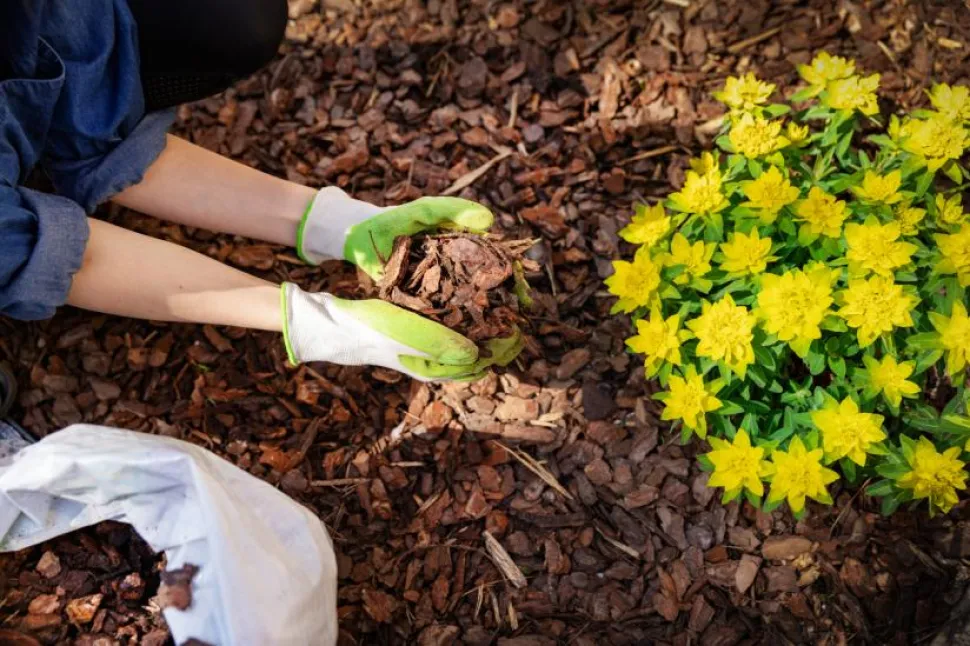
Mulching requires very little effort and offers many benefits.
- Reduce water evaporation
With a five to seven centimetre layer of mulch, the sun's rays don't penetrate the soil. The temperature is reduced by seven to ten degrees. The soil retains moisture longer. You reduce water evaporation and space out watering.
- Protecting the plant from the cold
Have you planted an olive tree even though you live north of the Loire? Would you like to protect your early-blooming primroses from the rigors of winter? Mulch! Mulch prevents the soil from freezing and preserves the plants. But don't wait. You need to start mulching in autumn, before the cold sets in. (Would you like more tips on how to protect your plants during the cold season? Read our article on How to protect your plants in winter?)
- Prevent the appearance of weeds
Mulching prevents light from penetrating the soil. It thus curbs the germination and spread of weeds. Thanks to mulching, you'll no longer need to use herbicides to control undesirable plants.
Mulching is also a solution for controlling rhizome growth. Bamboo, small periwinkle and mint quickly get out of control in the open. By mulching around your hedge or flower bed, you can put a stop to the invasion.
- Enrich the soil
Mulching isn't just good for your plants. It's also good for the soil. It protects the soil from temperature changes and prevents the formation of a crust.
Last but not least, it encourages the development of micro-organisms and earthworms that transform organic matter into minerals, essential for plant growth. Your soil becomes more fertile and requires less fertilizer.
What are the different types of mulch?
Depending on your tastes and expectations, you can choose organic, mineral or textile mulch.
- Organic mulch
Biodegradable and plant-based, organic mulch is made from :
- dead leaves ;
- maritime pine bark ;
- cocoa shells ;
- flax chaff ;
- grass clippings ;
- white wood or conifer sawdust;
- hemp chaff..
Organic mulch decomposes into humus and becomes a natural fertilizer. It enriches the soil with micronutrients and trace elements, while recycling green waste. If your soil is poor, this is the mulch of choice.
But organic mulch has a few drawbacks. It degrades rapidly and must be replaced regularly to keep the soil well protected. To mulch your shrubs and perennials, opt for materials that last several months, such as hemp chaff, flax or straw.
Another negative point is that organic materials absorb and retain a lot of moisture. Avoid installing it at the foot of spike Lavender, Santolinia, Grevillea or any other species that hates to stay wet.
But organic mulch has a few drawbacks. It degrades rapidly and must be replaced regularly to keep the soil well protected. To mulch your shrubs and perennials, opt for materials that last several months, such as hemp chaff, flax or straw.
Another negative point is that organic materials absorb and retain a lot of moisture. Avoid installing it at the foot of spike Lavender, Santolinia, Grevillea or any other species that hates to stay wet.
- Mineral mulch
Mineral mulch requires no maintenance. Once installed, it resists the elements and doesn't get damaged. Used properly, it even becomes an aesthetic feature of the garden.
But mineral mulch adds no micronutrients to the soil. Inert, it doesn't fertilize the soil and doesn't contribute to the development of local fauna.
If you want to use mineral mulch, opt for :
But mineral mulch adds no micronutrients to the soil. Inert, it doesn't fertilize the soil and doesn't contribute to the development of local fauna.
If you want to use mineral mulch, opt for :
- slate ;
- pozzolan ;
- pebbles ;
- gravel (granite, quartz, marble) ;
- clay balls ;
- crushed rock ;
- decorative pebbles;
- crushed glass.
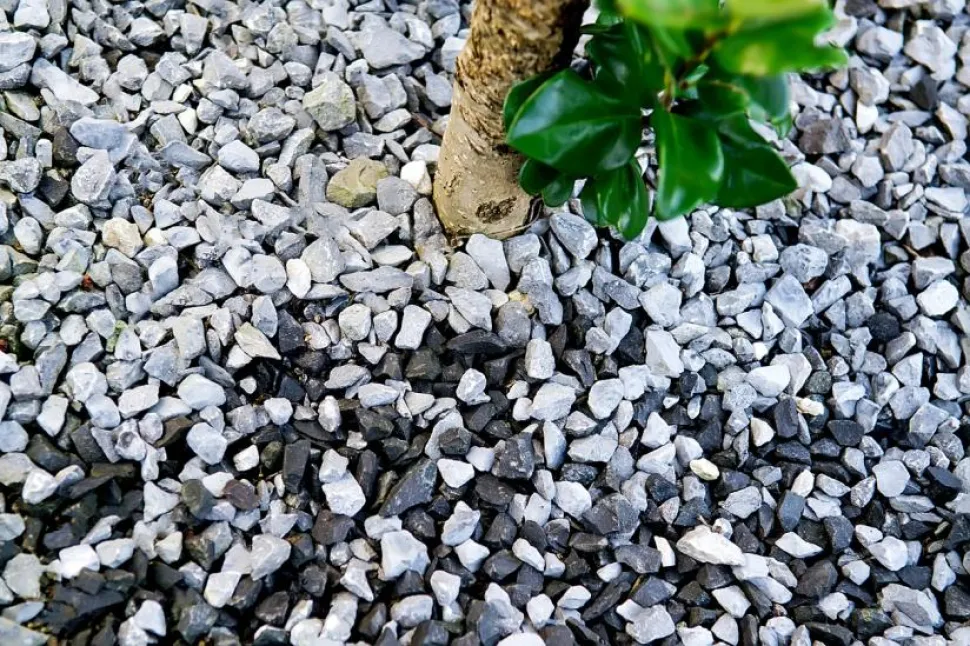
Mineral mulch brings a touch of Zen to the garden
Mineral mulch appeals to rockery plants and all varieties that like warmth, but not humidity. Agave, crassula arborescens, succulents and cacti will flourish amid pebbles and gravel.
- Textile mulch
Textile mulch is a polypropylene tarpaulin fastened to the ground with metal staples or claws. It can be placed at the foot of a flower bed, on an embankment or in the vegetable garden... It can also be used for driveways and borders.
Highly effective in preventing weeds and suckers from proliferating, mulching fabric lasts up to 15 years. It is resistant to weather, UV rays, temperature variations and even trampling.
In the vegetable garden, textile mulch is a real ally. As it warms the soil in spring, vegetables grow earlier and faster. Finally, it keeps your crops clean by preventing them from touching the soil.
The main drawback? It's ugly. Having a piece of plastic at the foot of your flower bed isn't in the best of taste. From a practical point of view, textile mulching has no effect on soil fertilization.
How do I mulch?
Mulching can be done at the time of planting or afterwards. To find out when to mulch, follow the advice given by the Monstera application. We'll tell you what type of mulch to use when planting, and when to protect your crops for the winter.
First step: weed the area to be mulched. Although mulch limits the proliferation of weeds, it doesn't make existing weeds disappear.
After weeding, you need to loosen and soften the soil. Add a little compost to the surface and water.
Spread the mulch in a thick layer of five to seven centimetres around the plants and shrubs in your garden. Be careful not to cover the collar (the point of separation between the roots and the stem). If you have young plants, start by mulching two to three centimetres. You can then top it up to seven centimetres.
Finally, water the mulch to moisten it.
First step: weed the area to be mulched. Although mulch limits the proliferation of weeds, it doesn't make existing weeds disappear.
After weeding, you need to loosen and soften the soil. Add a little compost to the surface and water.
Spread the mulch in a thick layer of five to seven centimetres around the plants and shrubs in your garden. Be careful not to cover the collar (the point of separation between the roots and the stem). If you have young plants, start by mulching two to three centimetres. You can then top it up to seven centimetres.
Finally, water the mulch to moisten it.
By Servane Nemetz
on 15-05-2023 at 15h56
on 15-05-2023 at 15h56



